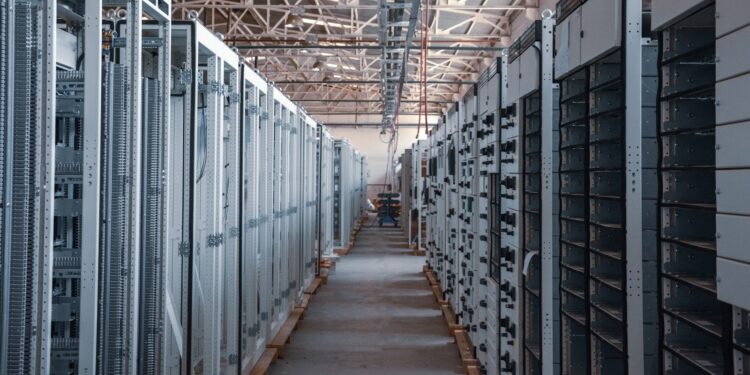The artificial intelligence (AI) revolution is reshaping not just technology but the very landscape of energy production. With data centers projected to consume up to 9% of global electricity by 2030, a high-stakes race is underway to secure land for “power sites”—specialized hubs combining renewable, nuclear, and hybrid energy systems to fuel AI’s colossal computational needs. This trend is buzzing across industries, driven by soaring AI demand, government incentives, and corporate net-zero pledges. Social media platforms like X highlight the excitement, with posts marveling at projects like a 2.6-million-square-foot data center in Cumberland drawing 300 MW, while others raise concerns over water usage and environmental impacts.
The U.S. and Canada are at the forefront of this land rush. In July 2025, the U.S. Department of Energy selected four federal sites—Idaho National Laboratory, Oak Ridge Reservation, Paducah Gaseous Diffusion Plant, and Savannah River Site—for AI data centers with co-located power generation. Canada’s push for AI sovereignty is fueling land acquisitions in hydro-rich provinces like Quebec and British Columbia. Companies are snapping up thousands of acres—think Texas plains for solar farms or Ontario’s industrial zones for small modular reactors (SMRs)—to create self-sufficient power sites. These hybrid setups, blending solar, wind, batteries, and SMRs, ensure reliable energy for AI’s 24/7 workloads, cutting grid dependency and operational costs by up to 25%.
The stakes are immense. Land prices in data center hotspots like Arizona and Ohio have surged 50-100%, driven by proximity to power grids and cooling water. Private equity is pouring in—Blackstone’s $100 billion data center portfolio and Apollo’s $6 billion Argo acquisition signal a booming market. Challenges persist: permitting delays, water scarcity (e.g., Google’s Oregon centers consuming 25% of local water), and community pushback, like xAI’s controversial Memphis project. Yet, the rewards are massive, with the AI infrastructure market projected to hit $7 trillion by 2030.
Investors are chasing “positive” stocks—those with strong land portfolios, recent deals, and analyst upgrades. Below, we spotlight six companies, public and private, in the U.S. and Canada, plus Pacifico Energy, a private U.S. player making waves in land-to-power development for AI and beyond.
The Power-Land Nexus: Fueling AI’s Future
AI’s energy demands are staggering—a single NVIDIA Blackwell rack can require 200 kW, pushing entire data center sites toward 1.5 GW, enough to power a small city. Traditional grids are buckling; U.S. electricity demand hit record highs in 2024, with AI adding 128 GW by 2030. Companies are bypassing grid constraints by acquiring land for on-site power generation, creating self-sufficient hubs. Governments are accelerating the trend: 2025 U.S. executive orders streamlined federal land leasing for AI projects, mandating clean energy, while Canada offers tax breaks for hydro-powered sites.
Hybrid systems are critical—solar and wind paired with batteries or SMRs ensure uninterrupted power. Social media reflects the stakes, with X posts praising innovations like Schneider Electric’s data center buildouts while flagging concerns over water-intensive projects in Arizona. The economics are compelling: land near power infrastructure is appreciating rapidly, and companies with strategic acquisitions are poised for 20-30% stock gains or private equity windfalls.
Six Trailblazers (Plus One) in the Land-to-Power Race
1. Amazon (AMZN) – Cloud Giant Building Power Campuses
Amazon, trading on NASDAQ, leverages its AWS dominance to acquire land for integrated power-data center campuses. In 2025, it secured 960 MW of nuclear power from Talen Energy’s Pennsylvania site and solar farms in Virginia on thousands of acres. AMZN’s stock is up 35% year-to-date, driven by AI cloud growth and energy deals. Its positive outlook stems from a $150 billion data center expansion plan, with analysts targeting $400+ per share.
2. NextEra Energy (NEE) – Solar Kingpin Expanding Land Banks
Florida-based NextEra, trading on NYSE, is the world’s largest renewable energy producer, acquiring vast tracts for solar and storage. In 2025, it bought 50,000 acres in Texas and Nevada for 2 GW projects, partnering with Meta for AI power. NEE’s stock rose 28%, with dividends and a 20 GW pipeline fueling positive sentiment. It’s a stable pick for green energy investors.
3. Brookfield Renewable Partners (BEP) – Transcontinental Land Buyer
Trading on NYSE and TSX, Canada-based Brookfield acquires land across the U.S. and Canada for hybrid power sites. Its $10 billion Microsoft deal includes sites for 10.5 GW of wind and solar, with Quebec hydro projects in progress. BEP’s shares gained 32%, a positive mid-cap bridging North American markets.
4. IREN Limited (IREN) – Small-Cap Scaling Renewable Sites
NASDAQ-traded IREN, with U.S. and Canadian operations, buys land for renewable-powered AI data centers. Its 2025 expansion in Texas added 1,800 acres for 2 GW, with British Columbia hydro sites in development. IREN’s stock doubled year-to-date, a positive high-risk, high-reward play.
5. Oklo Inc. – Private Nuclear Innovator on Federal Lands
U.S.-based private company Oklo develops SMRs on acquired federal land, including Idaho National Laboratory’s 2025 DOE lease. Valued at $1 billion, its non-trading status attracts venture capital, with potential IPOs signaling 30x returns.
6. Innergex Renewable Energy (INE.TO) – Canadian Hydro Leader
TSX-traded Innergex buys British Columbia land for hydro and wind projects. In 2025, it secured 500 MW for AI data centers. INE’s stock is up 22%, a positive pick for Canadian renewable investors.
7. Pacifico Energy – Private Developer Powering Communities
Pacifico Energy, a private U.S. company, transforms vacant land into hybrid power sites for data centers and communities. In 2024, it completed 21.8 MW of solar and 21.3 MWh of battery storage across California and Massachusetts, including the Bernardston Community Solar Project (6.735 MW) and Ventura Coastal Projects for AI and industrial clients. In June 2025, CleanCapital acquired its 27 MW portfolio, signaling strong monetization potential. Pacifico’s strategy—buying land for distributed generation—positions it for future deals with hyperscalers, with a 2025 focus on prime generation microgrids. Non-trading but venture-hot, it’s a private gem for high-return seekers. Learn more at www.pacificoenergy.com.
The Horizon: Risks and Riches
The land rush faces challenges—permitting can take years, and communities protest water-intensive projects, as seen in Arizona and Georgia. Yet, with AI’s $7 trillion market and innovations like floating nuclear platforms, the upside is immense. Public stocks like AMZN, NEE, BEP, IREN, and INE.TO offer immediate investment opportunities, while Oklo and Pacifico promise private equity jackpots. As AI rewrites the energy landscape, these land-to-power pioneers are building the grid of tomorrow—one acre at a time.




















